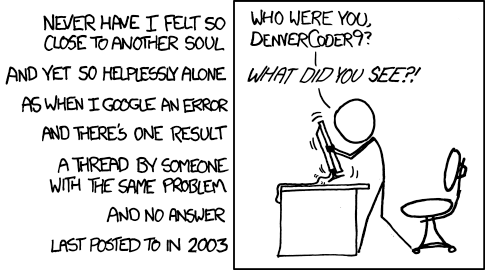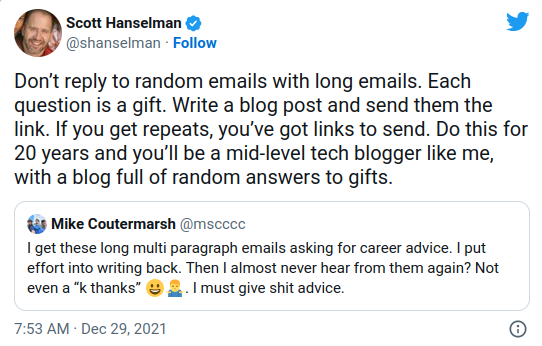Practices and Rituals for Building Open Knowledge
Working with the Garage Door Up
I really like this analogy that Andy Matuschak pinched from author Robin Sloan.
The idea is that we should, wherever possible, work work in a public place, talking openly about problems we've yet to solve and stuff that doesn't work yet. In doing so we:
- May help others who are facing similar problems and our future selves. I'm certainly guilty of solving problems transiently and then months later thinking "hang on a minute, I swear I've done this before".

XKCD 979: Wisdom of the Ancients
Sharing knowledge benefits everyone so we should do it openly and frequently! - Get to hold ourselves accountable and be held accountable: if you promise something in public you're much more likely to go through with it than if you kept it to yourself.
- We fight back against unrealistic "instagram" success and give a more authentic glimpse of what incremental progress looks like. Things don't magically pop into existence, they often take weeks, months or years to be built. We are used to highly curated feeds of social influencers who present themselves as magically successful and hide their labours and I think that's a bad expectation of what life is like for us to be setting for each other.
Publish, Don't Send
In this blog post, Herbert Lui talks about how it is often better to write publicly than it is to just send stuff as an email (and if full public isn't an option then you could write an internal team blog or something along those lines):
15/5 Updates
In this blog post (mirror) Shaun 'swyx' Wang writes about a practice called 15-5 reports: a weekly report that you spend 15 minutes to produce that can be digested by readers in 5 minutes. Send your report to your managers and peers to let them know what's going on and avoid keeping your progress bottled up and siloed.
This format was originally created by Yvon Chouinard of Patagonia in the 1980’s. As Swyx explains:
- Chouinard’s format uses 4 sections:
- This week (completed activities, notable wins, what’s working)
- Next week’s priorities
- Challenges/Roadblocks
- Lessons Learned/Opps for improvement

